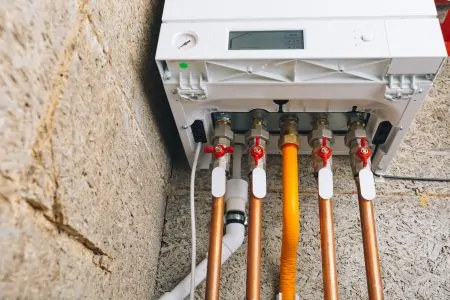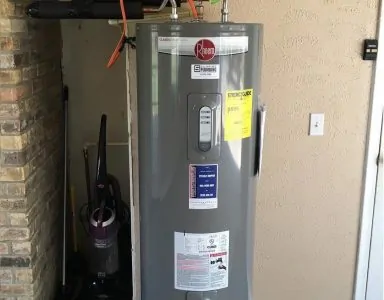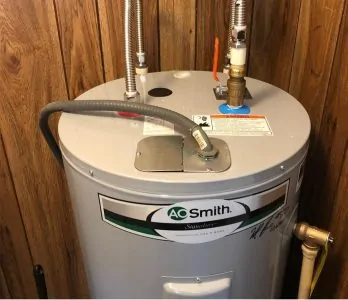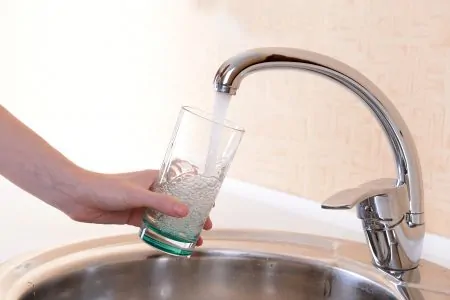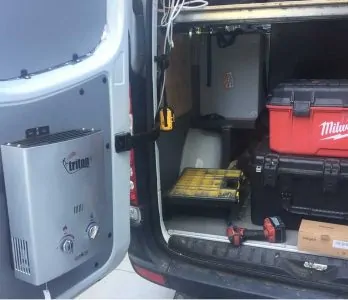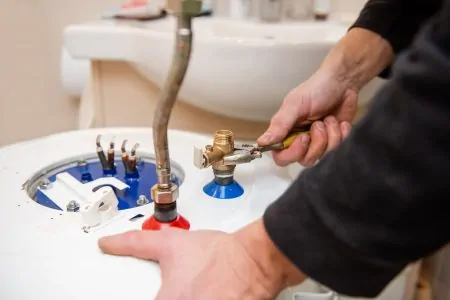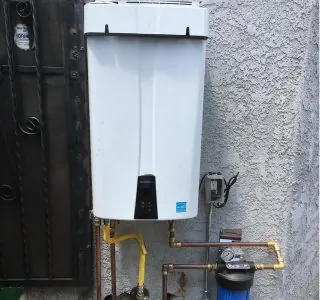Have you ever wondered how a water heater actually works? Perhaps you want to replace your current unit but you aren’t sure which type is the best fit for you.
There are several types of water heaters, each powered by different fuels and using unique methods to heat the water. Understanding how a water heater works will help you choose the unit that is the most suitable for your household and lifestyle.
In this article, we will explain the most important components that are found in water heaters. Then we will explore the different types of heaters to give you a deeper understanding of how they work.
Key Takeaways
- Water heaters come in various types, including traditional tank-type, tankless, heat pump, and solar water heaters.
- All water heaters have common components such as cold water inlet, hot water outlet, and heating elements or burners.
- Tankless water heaters provide hot water on-demand without the need for a storage tank, whereas tank-type heaters store hot water until needed.
- Proper maintenance and understanding of your water heater type can help extend its lifespan and improve efficiency.
Common Water Heater Components
In the world of water heaters, there are traditional and modern models. Tank-type electric and gas water heaters are generally considered traditional. Tankless and hybrid units are usually classified as modern models.
Although there are some major differences between traditional and modern units, they still share some common components. These include:
1. Cold Water Inlet
This is a standard part of any water heater. The cold water inlet pipe channels the water into the unit. Every water heater needs to have one in order to receive the water to heat.
2. Dip Tube
A dip tube is included in large tank-type units, except those with a cold inlet pipe at the bottom. It is essentially an extension to the top cold water inlet pipe, connected to the bottom of the tank.
As the hot water will naturally rise to the top, the dip tube directs the cold water to the bottom first. Once there, it receives heat before mixing with the hot water.
The dip tube also serves another purpose: it puts extra pressure on the cold inlet water, causing some turbulence at the bottom of the tank. This helps to circulate the suspended sediments, preventing them from settling on the tank and forming crusts.
3. Hot Water Outlet
This is another universal pipe. It is connected to the water heater and channels the hot water toward your faucet or other outlets.
4. Flue Pipe
The flue pipe is an essential part of every gas water heater, whatever the type. Gas-fired units use combustion, producing harmful fumes such as carbon monoxide. The flue pipe acts as an exhaust, venting the harmful gases created during the heating process.
5. T&P Valve
T&P valve is short for “temperature and pressure relief valve” and it’s a very important part. In fact, if it wasn’t there, the tank could explode.
It allows any excess pressure or heat to escape from the hot water tank and prevents an explosion. It probably goes without saying but this is essential, so if yours is broken you must replace it immediately.
6. Anti Corrosion Anode Rod
An anti-corrosion anode rod is an important part of any tank-type unit. They are small metal elements, usually made from either aluminum or magnesium with a steel core. The rods are installed near the dip tube and extend into the tank.
The theory behind an anode rod is that it attracts the corrosive elements in the water before they can attack the tank. When the anode rod has corroded, the water will begin to attack the tank instead. If the rod is allowed to corrode without being replaced, your tank will be left vulnerable to permanent damage.
Most anode rods last for one or two years before needing a replacement.
7. Electric Heating Elements
Electric heating elements are only installed in electric water heaters. They are the elements that heat the water inside the tank. They’re simple metal rods, much like you would see in an electric oven.
Depending on the size of the tank, it might have two elements while smaller tanks have only one. Some modern water heaters such as heat pump hybrids or solar also have one or two electric heating elements as backups.
8. Burner
The burner heats the water in a gas water heater. It is usually at the bottom of the tank in a compartment where the gas comes out and is ignited. Tankless gas units also have a burner in the middle with a fan underneath, keeping the flame alive.
Gas water heaters usually also have something called a “thermocouple.” This is a vital safety feature that turns off the gas in the event that the flame goes out.
How Does a Water Heater Work?
Now that we have some knowledge of the most important water heater parts, it’s time to see how they actually work.
Gas Water Heater
A gas water heater works with either natural gas or liquid propane. When you turn on your water heater, cold water is fed into the unit via the dip tube. The cold water is channeled to the bottom where the burners are positioned in a small compartment.
As the burner burns the gas, it releases extremely hot air that rises up through the flue or chimney. As the hot air travels through the chimney, it heats it, which in turn heats the water. This hot air is also very toxic so it must be vented to the outside.
This process depends on whether your unit is atmospheric or power-vented. If your unit uses natural convection, it likely has a draft diverter.
The draft diverter collects the toxic air before releasing it through the final part of the chimney. The diverter might cause something called “back drifting.” This is where some of the toxic air runs out of the chimney and into the room.
If your unit is power vented, it uses a small motor to pump the air out of the exhaust. Thanks to this, there shouldn’t be any back drifting.
When you open a hot water tap, more cold water is fed into the tank. The cold water forces the hot water through the heat-out pipe and the rest of your plumbing to reach your faucet.
Almost all water heaters have a thermostat where you can adjust the temperature that water is heated to. On gas boilers, this is connected to the gas line to control the amount of gas that reaches the burner.
Electric Water Heater
Electric water heaters use electric heating elements rather than gas-fired burners. An electric unit usually requires a 220-volt circuit to work. However, there are some that allow for more or less.
On the side of the tank, there are one or two thermostats, depending on the size. If it has two, there is usually one at the bottom and one at the top. Each thermostat is connected to a heating element that it controls.
As the dip tube feeds water into the bottom of the tank, the lower thermostat detects the cold temperature.
When the thermostat switch senses a cool temperature, it opens up to allow an electric current through the element. As the tank fills with water, it soon reaches the upper thermostat, which then activates the upper element.
When the water reaches the preset temperature, the thermostat closes to prevent overheating. Most electric water heaters have an external thermostat that allows you to set your desired temperature. They usually have a range between 120 degrees to 140 degrees Fahrenheit.
When you open a hot water tap, more cold water is let into the tank. Much like a gas unit, it forces the heated water up through the heat-out pipe.
Electric water heaters don’t produce any exhaust fumes so there’s no need for venting. You can safely place them anywhere in your home.
Tankless Water Heater
Tankless water heaters are often referred to as “on-demand” units. As their name suggests, they don’t have a storage tank and instead deliver hot water when it is needed. This eliminates the time spent waiting for a hot water tank to be filled and heat its contents.
A tankless unit can work using either a type of gas or electricity — they have both burners and heating elements.
When you open a hot water tap, water is allowed into the unit. Inside, a long pipe circulates around the heat exchanger. The inlet water pipe channels the water to the bottom of the exchanger that receives heat from the power source.
As the pipes channel the water from the bottom to the top, the water becomes warmer until it reaches the right temperature. It is then pushed out through the hot water outlet, directly to your faucet. This process usually takes less than a minute, depending on your unit.
Despite working indefinitely, tankless water heaters have a limited flow rate which means they aren’t ideal for simultaneous use. They work best when you install them for point-of-use applications, such as near a faucet or dishwasher.
An average flow rate is 2 to 5 gallons per minute. Gas-fired units usually have higher flow rates than their electric counterparts. However, even with a stronger flow, they might still struggle with multiple applications.
In these cases, it’s recommended that you install an extra unit or two throughout your home. You could even install a separate one near an appliance that uses a lot of hot water such as your dishwasher.
This may sound like a lot of trouble but tankless units are very energy efficient. They could save you 27% to 50% on your energy bills if you install a dedicated one for each appliance (1).
Heat Pump Water Heater
Heat pump water heaters provide the best efficiency. They don’t generate heat directly but instead move the heat using electricity. This method makes them two or three times more efficient than a traditional electric unit (2).
Heat pumps work by drawing heat from the surrounding air and transferring it into a tank where it heats the water. The hot air increases the temperature, enough to heat the water to 130 to 140 degrees Fahrenheit.
From this point, the rest of the process is quite similar to traditional units. The hot water is forced through the plumbing to your faucet as the tank refills.
This type of water heater requires a suitable spot in your home for installation. The best area is one where the temperature stays within 40 to 90 degrees Fahrenheit all year. There should also be an air space of 1,000 cubic feet around the unit.
Solar Water Heater
Solar water heaters are no longer the new kids on the block, but they have improved significantly over the years. Newer systems include a storage tank and a solar collector, of which there are two types: active and passive (3).
Active systems feature a circulating pump and control, meaning they depend on technology. A passive system, on the other hand, works without electricity and relies on natural convection to move the heat around.
To complicate this further, each kind has two types of heating systems. These are:
Active Solar Heating System
- Direct circulation system: This system consists of pumps that circulate inlet water inside the collectors and through to your home. They are best in warmer climates.
- Indirect circulation system: These also use pumps but here, they circulate a non-freezing, heat-transferring fluid. It passes through the collectors and then a heat exchanger which heats the water before it reaches your outlets.
Passive Solar Systems
These systems are usually less expensive and may last longer. However, they are less efficient.
- Integral collector-storage passive system: This system is best in areas where temperatures stay above freezing. They are great for households that use more hot water during the day and early evening.
- Thermosyphon system: This system is installed below the storage tank so when the hot water rises, it automatically flows into the holding tank.
Solar-powered water heaters must have a well-insulated storage tank. They also have additional inlet and outlet pipes that are directly connected to the collector.
